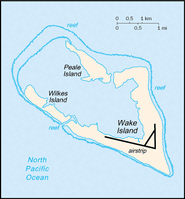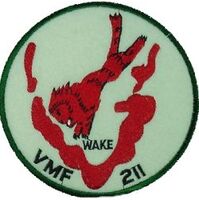This article does not cite any references or sources. (June 2008)
Please help improve this article by adding citations to reliable sources. Unverifiable material may be challenged and removed.
The Battle of Wake Island was the first encounter of American and Japanese infantry in the war. The attacks on the Island began simultaneously with the Attack on Pearl Harbor on December 8, 1941 (It was past the international date line). Wake Island has Wilkes and Peale Island almost connecting to it to the west.
Major Interest[]
The Japanese wanted Wake Island because they felt it was a threat to the Marshall Islands, which the Japanese held just a few hundred miles to the south. Wake was long enough to build an airstrip, and it was in range for bombers to hit major Japanese defenses. There already was a Naval Base and they allowed PAN-AM to us it as a tourist actraction. Wake was described as "Golfer's Paradise".[citation needed]

Wake, Wilkes and Peale Island was surrouned by a coal reef
Defenders[]

VMF-211 insignia with the Tiger and Wake Island
There were 449 men from the 1st Marine Defense Battalion on the island under the command of Major James P.S. Devereux. Also, there were 68 U.S. Navy Men and about 1,220 civilian workers. They were armed with six 5-inch cannons taken from destroyed cruisers, 12 3-inch M3 Anti-Aircraft Guns (Only One Had A Working AA sight, 18 Browning M2 .50 Heavy Machine Guns, and 30 heavy, medium and light water and air-kooled machine guns. On November 28 of 1941, United States Navy Commander Winfield Cunningham took command of the island.
First strikes[]
On the same day as Pearl Harbor, 36 Japanese Medium bombers toar up the American aircraft parked at the airfield. They destroyed 8 of the 12 original F4F-3 Wildcat fighters which were in use by the Marine Corp figher squadron (VMF-211) operating there. The defensive emplacements were left intact, but the aircraft were devastated.
First & Second Landing Attempts[]
On December 11, the remaining F4F Wildcats and the Marine's 5-inch guns opened up on the invasion fleet and sunk Hayate Destroyer and hitting Yubari light cruiser's superstructure 11 times. They also sunk another destroyer, the Kisaragi with a direct hit on the ship's depth charges. For the next attempt, because of the resistance of the Marines, they released 2 aircraft carriers (Soryu and Hiryu). On December 23, the same force plus more, with an addition of 1,500 Japanese Marines. The landings began at 2:35 with a bombardment right before. Patrol Boats No. 32 and 33 were destroyed in their attempt to land troops. After a whole night and morning of fighting, the Wake garrison surrendered to the Japanese. The garrison lost 49 Marines, 3 from the U.S. Navy and at least 70 civilians. The Japanese recorded loses of 700-900 killed and at least 1,000 more wounded. Also were the 2 destroyers sunk in attempt and 28 either land-based or carrier-based aircraft shot down during the 15 day siege.